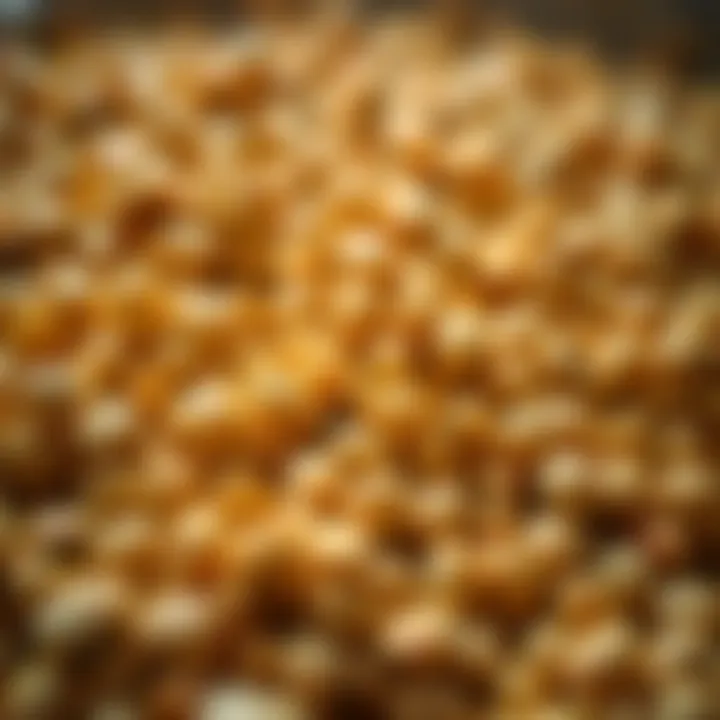Exploring Chemical Seed Treatment in Agriculture


Intro
In the world of agriculture, chemical seed treatments stand as a pillar of modern farming practices. As the global demand for food continues to rise, farmers are under increasing pressure to enhance crop productivity while also mitigating risks posed by pests, diseases, and environmental factors. This article dives into the realm of seed treatment, exploring its methodologies, historical evolution, and its role in shaping sustainable agricultural practices. By peeling back the layers of this subject, we aim to provide a robust understanding of how chemical seed treatments not only elevate crop health but also contribute to long-term sustainability in farming.
Topic Overview
Definition and Importance
Chemical seed treatment entails the application of chemicals to seeds before planting, aiming to protect them from harmful agents and improve germination rates. This practice has gained traction due to its proved benefits, including increased seed vigor, enhanced resistance to pests and diseases, and better adaptation to environmental stressors.
Farmers often find themselves caught between maximizing yield and maintaining safe agricultural practices; chemical seed treatment offers a balance. By providing an initial defense mechanism, these treatments allow crops to establish a strong foundation, which can ultimately lead to improved yields and healthier plants. It turns out that what happens at the seed level can set the tone for the entirety of the growth cycle.
Brief History and Evolution
Historically, seed treatment can be traced back to ancient agricultural practices whereby farmers would soak seeds in various natural substances to enhance germination and ward off pests. However, the introduction of synthetic chemicals since the mid-20th century revolutionized this practice, leading to the development of a wide range of products targeting specific plant diseases and pests.
In recent years, as concerns regarding environmental impact have surged, research has pivoted towards creating more sustainable and eco-friendly chemical treatments. This evolution reflects a growing awareness of the delicate balance between boosting agricultural output and protecting our planet's resources. With a focus on sustainability, innovative methods are being integrated into seed treatment processes, emphasizing safety and efficiency in agriculture.
Key Techniques and Innovations
Sustainable Farming Practices
Embarking on sustainable practices does not mean abandoning chemical seed treatments. Instead, the focus is on integrating these treatments with safer substances and methods that minimize adverse effects on ecosystems. For instance, biopesticides derived from natural materials have started gaining popularity. They offer a less harmful alternative to conventional chemicals while still providing effective protection for seeds.
Moreover, adhering to integrated pest management strategies can complement chemical seed treatments, leading to a holistic approach to farming that emphasizes the health of both crops and the environment. Using a combination of tools—such as resistant varieties, cultural practices, and biological controls—farmers can achieve a more balanced system.
Advanced Agronomic Technologies
Technological advancements have paved the way for more precise application methods in seed treatments. Components like seed coatings and encapsulation technology enable targeted delivery of active ingredients, ensuring that the seeds receive optimal protection without excessive chemical use.
By employing precision agriculture tools, farmers can now analyze soil and climate data to tailor their treatments per field requirements. Drones and soil sensors are becoming prevalent tools for monitoring crop health and making informed decisions about seed treatments, further bridging the gap between technology and traditional farming.
Practical Applications
Step-by-Step Guides
- Seed Selection: Choosing the right seed variety is crucial. Farmers should opt for seeds that meet their specific conditions and goals.
- Chemical Selection: Depending on the anticipated threats (pests, bacteria, or environmental challenges), select the appropriate chemical treatment.
- Application Timing: Treat seeds shortly before planting for maximum effectiveness. Follow manufacturer guidelines to ensure proper usage.
- Monitoring Growth: After planting, regularly check crop health to evaluate the efficacy of your chosen seed treatment.
- Record Keeping: Maintain detailed records of all treatments applied, including chemicals used, application timing, and observed effects on crop yield.
Case Studies or Real-World Examples
One notable example can be found in a number of corn fields in the Midwest. Farmers who embraced advanced seed treatments have reported yield increases of up to 15% compared to those who did not apply any treatments. The success stories of these farmers shine a light on the impact and potential of chemical seed treatments when combined with innovative practices.
Another target crop, soya, has also seen significant benefits. A case study showed that using a biological fungicide as part of a chemical seed treatment regimen led to a noticeable decrease in disease incidence, ultimately translating into a healthier crop and boosted returns.
"Chemical seed treatments represent a tangible fusion of science and agriculture, enabling farmers to sow seeds with greater confidence and assurance of yields."
Epilogue
As these advances continue to unfold, not joining the conversation may mean being left behind. The journey into the complexities of seed treatment illustrates that the stakes are high, and every decision counts.
Prolusion to Chemical Seed Treatment
Chemical seed treatment plays a pivotal role in modern agriculture, acting as a line of defense against various pests and diseases that threaten crops. With the ongoing challenge of climate change and ever-evolving agricultural practices, understanding this form of treatment becomes essential for farmers and agricultural enthusiasts alike. The importance of this topic extends beyond mere crop protection; it encompasses the very foundation of agricultural productivity and sustainability. This section aims to provide insight into why chemical seed treatment is a critical consideration in today’s farming landscape, particularly in improving plant health and promoting higher yield potential.
Definition and Overview
Chemical seed treatment involves applying chemical substances to seeds before they are planted. These treatments can serve multiple purposes, from protecting against fungi and insects to enhancing nutrient absorption. When a seed is treated, it often wears a coat of protection against the diseases and pests that could inhibit its growth. This process typically improves both germination and establishment, allowing seeds to grow stronger and healthier.
The dynamics of chemical treatments involve precise applications that can either enhance the vitality of the seed or, if not executed properly, lead to adverse effects. Thus, understanding the nuances of these treatments is paramount for effective agricultural practices.
Historical Context in Agriculture
Tracing the roots of chemical seed treatments reveals a fascinating development in agricultural practices. Historically, agricultural societies relied heavily on traditional methods such as crop rotation and manual seed inspection. With the advent of industrialization in agriculture during the late 19th and early 20th centuries, the introduction of synthetic chemicals sparked a revolution.
The first substantial use of chemical seed treatment can be credited to the introduction of fungicides, which aimed to combat seed-borne diseases that could devastate crops. For instance, the first recorded use of such treatments can be traced back to the early 1900s when farmers began to use mercurial-based compounds to protect seeds. Over the decades, more sophisticated treatments have emerged, adapting to the growing demands of agricultural efficiency.
Today’s chemical seed treatments not only focus on disease and pest control but also include nutrient fortifications to ensure that seeds perform optimally in varying environmental conditions. These historical advancements highlight how the integration of science and technology in agriculture has shaped modern practices, redefining what it means to cultivate healthy and productive crops.
Mechanisms of Chemical Seed Treatment
Chemical seed treatments play a vital role in contemporary agriculture, where precision and efficiency are critical to crop success. Understanding the mechanisms behind these treatments is essential not only for agricultural practitioners but also for enthusiasts who are keen to optimize their planting strategies. The efficacy of chemical seed treatments relies on several interconnected processes that ensure seeds are well-protected during their critical growth phases. This section dives into these mechanisms, shedding light on how they function, their benefits, and the considerations that must be kept in mind.
How Chemical Treatments Work
At its core, chemical seed treatment involves the application of specific substances to seeds before planting. These substances vary, but common categories include fungicides, insecticides, and nutrient enhancers. Each of these plays a distinct role in promoting seedling health and growth.
- Fungicides target pathogens that can jeopardize seed viability, combating threats like Fusarium and Phytophthora.
- Insecticides prevent damage from pests such as seed corn maggots or wireworms, effectively safeguarding seeds long enough for them to germinate and establish.
- Nutrient enhancers provide essential elements, supporting early plant development well in deprived soils.
The integration of these chemicals works at a microscopic level as they interact with the biological systems of the seeds. Importantly, formulations deliver active ingredients that can inhibit growth of unwanted organisms or bolster nutrient absorption, ensuring a robust start for seedlings.


Absorption and Distribution within Seeds
Once the treatment is applied, the chemical compositions begin their work primarily through processes that involve absorption. Seeds, generally composed of diverse structures like the seed coat, endosperm, and embryo, have unique ways of taking in these chemicals. The dominant mechanism involves penetration through the seed coat, which can be tougher for some seeds than others.
Once inside, the distribution of these chemicals occurs through the vascular system of the seed. This distribution is characterized by two crucial functions:
- Local Protection: Chemicals create a protective barrier around critical parts of the seed, serving as a localized defense system.
- Systemic Activation: As the seed germinates, these chemicals can move to emerging tissues, proactively continuing to fend off pests and diseases in the developing seedling.
This effective absorption and distribution not only enhance protection but can also aid in the early establishment of seedlings, setting them on a strong footing against adverse conditions.
Impact on Germination Rates
The application of chemical treatments can notably affect germination rates—an essential factor for any farming operation. When seeds are treated appropriately, they tend to sprout faster and more uniformly compared to untreated seeds. This can be attributed to the following aspects:
- Disease Resistance: Treated seeds are less likely to be compromised by pathogens that delay or inhibit germination.
- Pest Management: Reduced pest pressure allows seeds to germinate without hindrance from predators.
- Enhanced Nutrient Access: Nutrient enhancers stimulate growth and encourage quicker sprouting by ensuring that seeds receive essential minerals effectively.
"Healthy germination sets the stage for a productive crop yield, making effective seed treatment paramount in modern agriculture."
In summary, the mechanisms of chemical seed treatments underscore their importance in enhancing agricultural output. With proper application, these chemicals can significantly improve seed health, leading to stronger, more resilient crops. The benefits gained from understanding these mechanisms are manifold, as they allow farmers to make informed decisions about the best methods to protect and nurture their crops in a competitive and sometimes unpredictable agricultural landscape.
Types of Chemical Treatments
Understanding the types of chemical treatments is essential for grasping how best to protect seeds and enhance their performance in the field. Each category of treatment serves a specific purpose, targeting various challenges that farmers face. By familiarizing ourselves with the nuances of these treatments, we can better appreciate their roles in improving crop health and yields.
Fungicides
Fungicides are a cornerstone of chemical seed treatment, particularly in regions with high humidity or damp soil conditions, where fungal diseases can thrive. These substances work by preventing or controlling diseases that could harm seedlings. For instance, common fungal threats like Fusarium or Rhizoctonia can spell disaster for young plants.
Using fungicides effectively involves selecting the right type for the specific fungal threat and understanding the timing of application. Getting it right not only boosts seedling vigor but can also minimize yield loss and reduce the need for later treatments. Unfortunately, continuous use of fungicides can lead to resistance, making it crucial to rotate them with other treatment methods to maintain efficacy.
Insecticides
Insecticides play a pivotal role in safeguarding seeds from a host of pests that can wreak havoc on crops. The importance of using insecticides lies not just in killing the pests, but also in protecting the seeds while they are most vulnerable during the germination stage.
Different types of insects, such as aphids or rootworms, pose unique threats, and hence the choice of insecticide should align with the pest profile of the region. Moreover, some insecticides can also offer systemic protection, meaning they are absorbed into the plant's tissues, providing long-lasting defense. One must tread carefully, though; excessive use can disrupt beneficial insect populations, thus upsetting the natural ecosystem.
Herbicides
Herbicides are key in weed management, making them a no-brainer for any effective seed treatment plan. Seedlings often compete against weeds for resources, and inefficient competition can lead to stunted growth or even crop failure. Applying herbicides as part of chemical seed treatment can mitigate these risks early in the growing season.
There are two broad categories of herbicides: pre-emergent and post-emergent. Pre-emergent herbicides are applied before weeds begin to grow, while post-emergent ones are used after weeds have emerged. Selecting the right type helps ensure crops get a head start against aggressive weed growth, ultimately contributing to increased productivity and lower management costs in the long run.
Nutrient Enhancers
Nutrient enhancers serve a somewhat different, yet equally important function. Unlike traditional seed treatments aimed at disease and pest control, nutrient enhancers focus on ensuring that seeds have all necessary nutrients during their most vulnerable period. These treatments often include micronutrients that can enhance seedling vigor and improve overall establishment rates.
Properly formulated nutrient enhancers support seedlings in overcoming stressors such as drought or nutrient deficiencies, ensuring robust growth and maximizing yield potential. This category reveals the intricate balance that farmers must strike between chemical use and sustainable practices, underscoring the need for careful planning in nutrient management.
In the world of agriculture, knowledge truly is power. Selecting the right treatment, whether it be a fungicide, insecticide, herbicide, or nutrient enhancer, can drastically influence crop health and farm sustainability.
By understanding and applying these different types of chemical treatments wisely, farmers can not only enhance crop yields but also safeguard against unforeseen threats that can lead to potential failures, thus playing a crucial role in agricultural success.
Benefits of Chemical Seed Treatment
Chemical seed treatment plays a significant role in modern agriculture, notably by enhancing various aspects of seed performance and, in turn, improving overall crop productivity. It’s not just a simple matter of applying chemicals to seeds; it is about providing a protective layer that ensures healthy plant growth, stronger resistance against pests and diseases, and an overall more resilient agricultural system. When farmers invest in chemical seed treatments, they're essentially bolstering the first step in the planting process, laying the groundwork for a fruitful season.
Enhanced Disease Resistance
One of the primary advantages of chemical seed treatment is enhanced disease resistance. Seeds can be vulnerable to a plethora of pathogens that can compromise their growth potential even before they've germinated. By treating seeds with fungicides, for instance, farmers can create an environment that significantly reduces the risk of diseases such as damping-off and root rot. This proactive stance is crucial because once a plant is infected, the costs associated with treatment and potential yield loss can skyrocket. Furthermore, the investment in disease-resistant seed treatment can lead to healthier, robust plants, which are better equipped to fend off future infections throughout their growth cycle.
Increased Crop Yields
The correlation between chemical seed treatment and increased crop yields cannot be understated. Studies show that treated seeds often result in higher germination rates and improved stand establishment, leading directly to more uniform crops. When seeds thrive from the get-go, they're more likely to mature fully and reach their yield potential. For example, a farmer who applies insecticidal coatings on their seeds could see significant reductions in pest activities, allowing the plants to absorb more nutrients and moisture instead of fighting off infestations. As a result, yields can surge, offering a more lucrative return on those initial investments.
Improved Seedling Establishment
Good seedling establishment lays the foundation for a successful harvest. Chemical treatments aid in creating optimal conditions for seeds to sprout vigorously and develop strong roots. This is especially true in challenging conditions, such as poor soil health or variable weather patterns. Seed treatments prepare the seeds to better navigate these trials. When a seedling establishes efficiently, it means more plants will survive to maturity, ultimately leading to denser cropping that enhances harvest potential. A farmer’s ability to predict the performance of their crops also improves with greater seedling establishment, allowing for better planning and resource allocation throughout the growing season.
Better Stress Tolerance
In today’s agricultural landscape, resilience to environmental stressors such as drought, salinity, and extreme temperatures is becoming increasingly vital. Chemical seed treatments bolster this resilience by essentially giving seeds a fighting chance under unfavorable conditions. Some treatments include nutrient boosters that work synergistically with the growing plants. For instance, applying a coating that contains micronutrients can help improve root development, making plants not just more robust but also more adaptable to stress. Having crops that withstand harsher conditions means that farmers can potentially extend their growing seasons and mitigate the impacts of climate variability.
"Chemical seed treatments are not just an additive in agriculture; they are a pivotal strategy that integrates science and farming."
The benefits of chemical seed treatment are multi-faceted, underscoring the importance of understanding these methodologies in modern agricultural practices. With enhanced disease resistance, increased crop yields, improved seedling establishment, and better stress tolerance, it becomes clear how these treatments contribute not only to the immediate success of individual crops but to the sustainable growth of the agricultural sector as a whole. Whether you're a seasoned grower or a new entrant into farming, appreciating the role of chemical seed treatments can be a game-changer.
Challenges and Risks Associated with Chemical Seed Treatment
The practice of chemical seed treatment has revolutionized agricultural productivity, but it isn't all sunshine and rainbows. While these treatments can provide crucial benefits, various challenges and risks loom large, affecting both their efficacy and the broader agricultural ecosystem. Understanding these challenges is vital for farmers and stakeholders who aim to strike a balance between effective crop protection and sustainability.


Risk of Resistance Development
One of the pressing concerns facing agriculture today is the risk of pests and diseases developing resistance to chemical treatments. Just like any other organisms, pests have a tendency to adapt. For instance, repeated use of a particular insecticide might initially yield great results, but over time, a population of pests may become resistant, rendering that chemical virtually ineffective. This phenomenon is not only frustrating for farmers, who may find their go-to solutions failing, but it also leads to an escalation in chemical use.
- Strategies to Mitigate Resistance:
- Rotate chemical classes: Avoiding over-reliance on a single type of chemical can help prolong its effectiveness. Incorporating different classes of insecticides or fungicides can slow down the resistance development.
- Integrated Pest Management (IPM): Combining chemical treatments with biological controls, crop rotation, and habitat management can provide a more holistic approach to pest management. This can not only reduce reliance on chemicals but also promote biodiversity on the farm.
Environmental Concerns
While the focus often remains on yield increases, the environmental implications of chemical seed treatments cannot be brushed aside. The runoff from treated seeds can contaminate soil and waterways, posing risks to non-target species and disrupting ecosystems. For example, bees and other pollinators can be negatively impacted by the chemicals, leading to a decline in their populations, which are critical for many crops. The challenge here is finding a middle ground where crop protection measures do not compromise environmental health.
- Key Environmental Issues Include:
- Water Contamination: Chemicals may leach into water sources, affecting aquatic life and drinking water quality.
- Soil Health: Continuous application of chemical treatments can alter soil chemistry and biodiversity, which is vital for soil fertility.
"The quest for increased productivity is commendable, but not at the expense of our environment. The future of farming hinges on sustainable practices that protect both crops and ecosystems."
Health Implications for Humans and Animals
The potential health risks associated with chemical seed treatments should also not be understated. Studies have raised concerns about chronic exposure to certain chemicals, linking them to various health issues in humans and livestock alike. For instance, farm workers who apply these chemicals may face higher risks of respiratory problems or skin irritations. Additionally, residues from treated seeds can persist in the environment, eventually making their way into the food chain.
- Health Risks to Consider:
- Long-term exposure effects: Inadequate protective measures during application can expose workers to harmful chemicals.
- Residue Concerns: Continued consumption of crops treated with certain chemicals might lead to health issues for consumers over time.
The challenges and risks linked to chemical seed treatments are multifaceted. Ultimately, addressing these concerns requires a collaborative effort among farmers, researchers, and regulatory bodies. By being aware of these issues, the agricultural community can take proactive steps to ensure farming practices evolve responsibly, safeguarding both human health and the environment.
Regulatory Framework
The regulatory landscape surrounding chemical seed treatments is a cornerstone of agricultural practice. This framework does not merely serve as bureaucratic oversight but rather as a vital mechanism to ensure the safety and effectiveness of these treatments. Understanding this framework is paramount for farmers and industry stakeholders, as it outlines what is permissible and sets expectations for compliance and product efficacy. Through regulations, the integrity of agricultural products is upheld, which, in turn, fosters trust in the food supply chain.
Global Regulations on Chemical Treatments
Globally, the regulation of chemical seed treatments can vary significantly from one country to another, influenced by local agricultural practices, environmental considerations, and public opinion. Some regions adopt stringent measures to safeguard human health and ecosystems, while others exhibit a more lenient approach.
In the United States, for example, chemical seed treatments fall under the jurisdiction of the Environmental Protection Agency (EPA). The EPA conducts thorough assessments of the active ingredients in seed treatments, examining their potential risks to humans, animals, and the environment. Only after a comprehensive evaluation can a product gain approval for use. Conversely, in Europe, the European Food Safety Authority (EFSA) sets a high bar, emphasizing no data no market principles, which can limit the types of chemicals available for use in seed treatments.
"Regulations are not just rules; they are the result of balancing innovation with responsibility"
This global patchwork often leads to inconsistencies, making it essential for farmers to stay abreast of both local and international regulations relevant to their operations. Compliance not only ensures immediate legal adherence but also opens avenues for international trade, as products need to meet the requirements of importing countries.
Safety Standards and Compliance
Safety standards in chemical seed treatment are not just regulatory checkboxes; they represent a commitment to safe agricultural practices. Compliance with these standards directly translates into better crop health and reduced risk of adverse effects on farmers and the surrounding community. Various standards, such as those from the International Organization for Standardization (ISO) and national agricultural bodies, provide guidelines that manufacturers must follow, ensuring products are both effective and safe to use.
Farmers should align their practices with these safety standards, which not only encompass the safe application of chemical treatments but also timings, application rates, and protective measures. Using improper amounts or applying treatments at the wrong time can lead to issues like chemical resistance or phytotoxicity—the adverse effects of chemicals on plants.
Furthermore, compliance often requires meticulous record-keeping and reporting. Documentation of chemical usage, including product data sheets and safety data sheets, becomes crucial. It not only provides traceability for regulatory audits but also reassures consumers about the safety of the food they consume.
In an ever-evolving agricultural landscape, staying updated with regulatory changes is vital for sustainable practices. This effort not only guarantees adherence but also enhances the credibility and viability of farming operations in the long run. Not to mention, farmers who are attuned to these regulatory nuances can make informed decisions regarding the adoption of new technologies, achieving a balance between productivity and safety.
Alternatives to Chemical Seed Treatment
Understanding the alternatives to chemical seed treatment is essential for farmers and agricultural enthusiasts looking to adopt methods that are both effective and sustainable. While chemical treatments provide numerous benefits, the environmental concerns and health implications associated with their use drive the interest in alternative solutions. This section examines biological seed treatments and integrated pest management strategies, highlighting their significance, effectiveness, and considerations.
Biological Seed Treatments
Biological seed treatments are quickly gaining traction as a reliable alternative to conventional chemical approaches. These treatments utilize natural organisms, such as beneficial bacteria and fungi, to promote seed health and enhance growth. Here are some key advantages and considerations:
- Natural Defense System: Biological treatments act like a bodyguard for seeds. They help them fend off diseases and pests without the harsh impact of chemicals. For instance, certain strains of Bacillus subtilis can suppress fungal pathogens that threaten germination.
- Soil Health Improvement: Unlike chemical alternatives, biological treatments can improve soil microbial diversity, leading to a healthier ecosystem. Healthy soils result in healthier plants, creating a virtuous cycle of plant health and yield.
- Resilience Against Stress: Seeds coated with beneficial microbes often exhibit improved tolerance to environmental stressors, such as drought and salinity. This is crucial in this age of changing climate conditions.
However, biological seed treatments require careful consideration:
- Efficacy Variability: They may not work the same way under all conditions. Farmers need to understand their specific soil types and climate conditions to maximize effectiveness.
- Longer Onset of Action: Unlike chemical treatments, which generally provide immediate protection, biological options may take longer to establish beneficial populations in the soil.
Thus, while biological seed treatments present promising benefits, they require complementary use with traditional practices to ensure a robust approach.
Integrated Pest Management Strategies
Integrated Pest Management (IPM) is another robust alternative to chemical seed treatments, focusing on a holistic approach to pest control. It involves the careful integration of different management options, including biological, cultural, physical, and chemical methods, when necessary. Some key points to consider include:
- Comprehensive Pest Control: IPM addresses not just prevention but also the monitoring and management of pest populations. By employing ecological principles, it enables farmers to act preemptively rather than reactively.
- Reduction of Chemical Reliance: Through practices such as crop rotation, intercropping, and maintaining habitat for beneficial insects, farmers can significantly reduce the need for chemical treatments. This minimizes potential environmental harm.
- Economic Viability: Implementing IPM can lead to cost savings over time. By reducing reliance on costly chemicals, farmers may see an increased profit margin.
Nevertheless, there are considerations:
- Knowledge Intensive: IPM requires farmers to have a good understanding of pest life cycles, ecology, and beneficial species. Education and management skills play a vital role in its effectiveness.
- Potential for Inconsistency: Maintaining control can be difficult during unexpected pest outbreaks, leading to occasional reliance on chemical solutions, making effectiveness vary.
For more information, visit USDA National Agricultural Library and Cornell University Sustainable Agriculture.


Articles discussing diverse agricultural practices can also be found on Wikipedia and Britannica.
Navigating the right balance of treatments takes time, knowledge, and adaptation, but the future of agriculture may very well depend on these sorts of integrated approaches.
Future Trends in Seed Treatment Technologies
As agriculture continues to evolve, so does the technology that supports its growth. The upcoming trends in seed treatment technologies are essential for encouraging productivity and sustainability, especially in an era marked by climate change and increasing food demands. These trends not only reflect the innovations in agricultural practices but also indicate a strong movement towards more responsible and effective farming methods. Understanding these future trends offers farmers and agricultural enthusiasts insights into maximizing crop yields while minimizing environmental impact.
Innovations in Biotechnology
Biotechnology is at the forefront of new seed treatment methods. One of the most significant advancements is the development of genetically modified seeds that incorporate pest and disease resistance directly into the seed's genetics. This means fewer chemical applications are necessary, leading to a decrease in the overall dependency on external pesticides. New varieties, such as Bt corn, demonstrate how genetic engineering can deliver inherent protection against pests, reducing crop losses and maintaining yields.
Moreover, biopesticides derived from natural materials are also gaining traction. These innovative products offer targeted pest control with less impact on non-target species, aligning with integrated pest management principles. They serve as a wonderful complement to existing treatments, opening doors to more sustainable crop production systems.
Precision Agriculture and Seed Treatment
Precision agriculture is emerging as a game changer in the realm of seed treatment. The use of technology such as drones, IoT sensors, and data analytics provides farmers with real-time insights into their fields. With such information, farmers can customize their seed treatment applications to meet the exact needs of specific areas within a field. This tailored approach ensures that inputs are applied only where necessary, significantly reducing waste and improving efficiency.
For instance, if a particular section of a field shows high susceptibility to certain pests, more focused chemical seed treatment can be applied there while leaving unaffected areas untouched. This not only conserves resources but also minimizes the risks associated with excessive chemical usage. As such technologies become more widespread, the integration of seed treatments into precision farming promises more sustainable agriculture practices.
Sustainability in Chemical Use
Sustainable practices are no longer a choice but a necessity for modern agriculture. The focus on minimizing chemical use and understanding its environmental footprint continues to rise. Future trends are shaping a landscape where seed treatments are increasingly designed with sustainability in mind. For example, many manufacturers are now looking into developing “smart” chemicals that break down more quickly in the environment, thereby reducing residue and potential harm to nearby ecosystems.
Additionally, biostimulants—natural substances that enhance plant growth—are being integrated into seed treatments. These stumulants help plants become more resilient to various stressors, thus potentially reducing the need for chemical treatments in the first place. Their role in enhancing soil health and promoting beneficial microbial activity makes them a valuable component of sustainable agricultural systems.
Case Studies: Successful Applications
The importance of case studies in the realm of chemical seed treatment cannot be overstated. These detailed investigations offer a real-world lens through which to examine the application and efficacy of chemical treatments across various agricultural scenarios. By focusing on specific examples, readers can better grasp the practical implications of chemical seed treatments, understanding their potential benefits, successes, and the challenges that might arise. This section aims to illustrate how particular crops, namely maize and soybeans, have benefitted from such practices, serving as valuable precedents for broader agricultural strategies.
Case Study: Maize Production
Maize has long been a staple in global agriculture, often called corn in many parts of the world. Its production can be impacted severely by pests and diseases, particularly in regions where environmental conditions favor these threats. A notable case is the use of chemical seed treatments in maize cultivation aimed at both enhancing germination rates and mitigating early-season pest pressures. In a 2020 study conducted in Iowa, farmers implemented a specific blend of fungicides and insecticides at the seed treatment stage.
The results were compelling: those using chemical seed treatments reported a 12% increase in crop yield compared to untreated seeds. Farmers noted that early pest infestations, particularly from fall armyworms and rootworm larvae, were significantly reduced.
Key benefits observed include:
- Higher Germination Rates: Treated seeds showed improved emergence under less than ideal conditions.
- Stronger Seedlings: The use of fungicides helped strengthen seedlings against damping-off diseases commonly triggered by soil pathogens.
- Overall Crop Vigilance: Farmers felt more at ease knowing their crops were shielded from early-stage pests, allowing them to allocate resources and labor more effectively.
This case highlights not only the effectiveness of chemical seed treatment in maize production but also illustrates how farmers can leverage these methodologies to maximize both yield and efficiency on their farms.
Case Study: Soybean Pest Management
Soybean crops face their own set of challenges, particularly from insects such as aphids and various types of beetles. Historically, these pests could ravage yields resulting in significant economic losses. A recent case study from Kentucky showcased a successful adoption of chemical seed treatment methods. In the 2021 growing season, a group of soybean farmers opted for a systematic approach where seeds were treated with an insecticidal compound prior to planting.
Outcomes were markedly positive, illustrating the key strengths of chemical seed treatments in pest management. Reports revealed that soybean fields utilizing treated seeds experienced a 15% reduction in pest-related damage when compared with untreated fields.
Notable Outcomes Included:
- Reduced Pest Populations: The insecticide in the seed treatment effectively curtailed the initial population growth of aphids, known for their ability to rapidly reproduce.
- Improved Return on Investment: With lower pest levels leading to higher yields, farmers reported an improved ROI from their soybean fields, which helped them reinvest in their operations.
- Smoother Harvesting: The overall health of soybean plants allowed for a smoother and more efficient harvesting process as well.
This case is a striking example of how chemical seed treatments can be leveraged not only to combat immediate threats but also to bolster overall agricultural productivity and profitability. The practical applications seen with maize and soybean farming illustrate the potential of chemical seed treatments and their critical role in setting up future agricultural success.
"Case studies provide living proof of the efficacy of chemical treatment – they are often the bridge between theory and practical farming success."
By examining these two case studies, one can appreciate the actionable insights that chemical seed treatments offer to farmers globally. These stories serve as testimonies to the importance of integrating science-backed practices into agricultural systems, underscoring the continued need for research and innovation in this field.
End and Recommendations
In the realm of modern agriculture, the significance of chemical seed treatment cannot be underestimated. This practice acts as a frontline defense against pests and diseases, helping to secure not just the health of the seeds but the potential yield of crops as well. By encapsulating various treatments, farmers enhance their ability to produce food sustainably and efficiently.
The benefits outlined throughout this article underline the necessity for farmers to consider incorporating chemical seed treatments into their cultivation strategies. First and foremost, enhanced disease resistance can lead to high-quality produce and improved marketability. Increased crop yields translate directly into better financial returns, which enable farmers to invest back into their operations, driving continued innovation and growth.
Moreover, improved seedling establishment and better stress tolerance further solidify the integral role chemical treatments play.
However, it’s essential for farmers to approach these treatments with caution. Regulatory frameworks and safety standards are in place to ensure the responsible use of chemicals, so adhering to these guidelines is crucial in mitigating potential risks. Understanding the environmental implications associated with their use helps to forge a path towards sustainable agricultural practices. By weighing their options carefully, farmers can make informed decisions that align with both their economic goals and environmental stewardship.
"Sustainable farming isn't just a trend; it's a necessity for the future of our planet."
Summarizing Key Points
To encapsulate the key takeaways from this article:
- Chemical seed treatments are vital for protecting seeds from disease and pests.
- They improve crop yields and enhance overall agricultural efficiency.
- Regulatory frameworks exist to protect human health and the environment from potential risks associated with chemical use.
- There are sustainable alternatives, fostering a balance between productivity and environmental health.
Moving forward, farmers, researchers, and agricultural enterprises should collaborate to foster practices that support and improve the sustainability of chemical seed treatments while simultaneously exploring innovative solutions.
Future Research Directions
Looking ahead, there are several avenues for advancement in the field of chemical seed treatment:
- Development of Eco-Friendly Compounds: There is a pressing need for research into biodegradable treatments that minimize ecological footprints.
- Integration of Smart Technologies: Investigating how precision agriculture tools can enhance application efficiency of chemical treatments could maximize benefits and minimize risks.
- Long-Term Impact Studies: Understanding the long-term effects of these treatments on soil health and crop diversity is vital for sustaining agriculture.
- Education and Best Practices: Ongoing education for farmers about chemical use, resistance management, and evolving regulations can foster a culture of responsibility.
Embracing these future directions not only holds the potential for improved agricultural practices but also paves the way towards a more sustainable and productive agricultural landscape.



